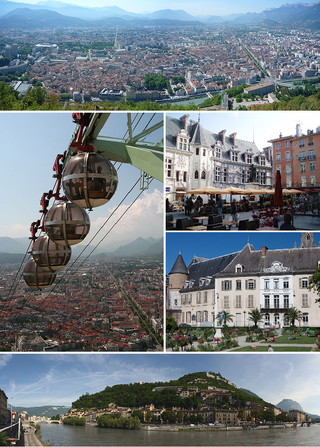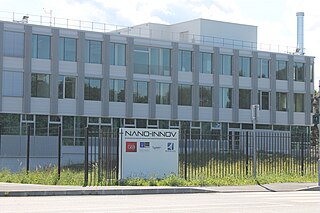
Grenoble is the prefecture and largest city of the Isère department in the Auvergne-Rhône-Alpes region of southeastern France. It was the capital of the Dauphiné historical province and lies where the river Drac flows into the Isère at the foot of the French Alps.

The École centrale de Lyon (ECL) is a research university in greater Lyon, France. Founded in 1857 by François Barthélemy Arlès-Dufour in response to the increasing industrialization of France, it is one of the oldest graduate schools in France. The university is part of the Grandes Écoles, a prestigious group of French institutions dedicated to engineering, scientific research, and business education. The current 45-acre campus opened in 1967 and is located in the city of Ecully.

The French Alternative Energies and Atomic Energy Commission, or CEA, is a French public government-funded research organisation in the areas of energy, defense and security, information technologies and health technologies. The CEA maintains a cross-disciplinary culture of engineers and researchers, building on the synergies between fundamental and technological research.

Nanotechnology education involves a multidisciplinary natural science education with courses such as physics, chemistry, mathematics, and molecular biology. It is being offered by many universities around the world. The first program involving nanotechnology was offered by the University of Toronto's Engineering Science program, where nanotechnology could be taken as an option.

The Grenoble Institute of Technology is a French technological university system consisting of eight engineering and management schools.
The Institut supérieur de l'électronique et du numérique is a group composed of four French grandes écoles. They propose a high level engineering program in ICT, micro- and nanotechnologies and innovative design.
Soitec is an international company based in France, that manufactures substrates used in the creation of semiconductors.

The Université Grenoble Alpes is a public research university and a grand établissement in Grenoble, France. Founded in 1339, it is the third largest university in France with about 60,000 students and over 3,000 researchers.
The economy of Rhône-Alpes is the second most dynamic economy in France and the 6th region in Europe. The economy of this region based on three major cities, Lyon, Grenoble and Saint-Étienne.

Lynred is a B2B company with headquarters in Palaiseau, France that designs and manufactures infrared (IR) detectors for military, space and commercial applications. LYNRED manufactures both cooled and uncooled microbolometers covering all infrared bands and is Europe’s leading supplier of this type of technology. The company’s headquarters are in Palaiseau, France and its R&D and production facilities are located in Veurey-Voroize in the Isère region of France.

The École Nationale Supérieure de Physique, Électronique et Matériaux is a Grande École located in Grenoble, France. Phelma is part of Grenoble Institute of Technology. The school specializes in physics, electronics and materials.
Institut des Nanotechnologies de Lyon (INL) or the Lyon Institute of Nanotechnology is a fundamental and applied research laboratory in the field of micro- and nano-technology based in Lyon, France. Its mission is to conduct research towards the development of full-fledged technologies for a broad range of application sectors.

CEA-Leti is a research institute for electronics and information technologies, based in Grenoble, France. It is one of the world's largest organizations for applied research in microelectronics and nanotechnology. It is located within the CEA Grenoble center of the French Alternative Energies and Atomic Energy Commission (CEA).

The École nationale supérieure de l'énergie, l'eau et l'environnement(Ense3) is one of the engineering schools of the Institut National Polytechnique de Grenoble. As a grande école, students are admitted through a nationwide competitive examination. It was formed by the merger of the École nationale supérieure d'hydraulique et de mécanique de Grenoble (ENSHM) and the École nationale supérieure d'ingénieurs électriciens de Grenoble (ENSIEG).

Alim Louis Benabid is a French-Algerian emeritus professor, neurosurgeon and member of the French Academy of Sciences, who has had a global impact in the development of deep brain stimulation (DBS) for Parkinson's disease and other movement disorders. He became emeritus professor of biophysics at the Joseph Fourier University in Grenoble in September 2007, and chairman of the board of the Edmond J. Safra Biomedical Research Center in 2009 at Clinatec, a multidisciplinary institute he co-founded in Grenoble that applies nanotechnologies to neurosciences.

The Polygone Scientifique, nowadays known as Presqu'Île (peninsula) is a neighborhood of the city of Grenoble in France. It includes a significant number of research centers in a peninsula between Isère and Drac.
Clinatec is a biomedical research center based at the Polygone Scientifique in Grenoble. Doctors, biologists and micro- and nanotechnology experts work side by side at the 6,000 m2 facility. Around a hundred researchers and employees work at the center. When it opened at the end of 2011, it was hailed as the first center of its kind in the world. With six hospital rooms, cutting-edge medical imaging equipment and an operating suite, Clinatec was developed by the Research Division of the CEA, Grenoble-Alpes University Hospital (CHU), Inserm and the Université Grenoble Alpes. The primary focus is on cancer, neurodegenerative diseases and disability.

CEA-List is one of three institutes of the French CEA technological research division CEA Tech. The institute specializes in digital systems. It has the Carnot label.
Xenocs is a scientific instrumentation company based in Grenoble, France, providing instruments, software and related services for x-ray characterization of materials, in particular Small Angle X-ray Scattering (SAXS) and Wide Angle X-ray Scattering (WAXS).















